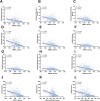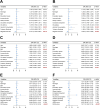Sexual difficulties in men who have sex with men living with HIV: their mental health and health-related quality of life
- PMID: 39310083
- PMCID: PMC11413803
- DOI: 10.1093/sexmed/qfae060
Sexual difficulties in men who have sex with men living with HIV: their mental health and health-related quality of life
Abstract
Background: Health-related quality of life (HRQoL) is gaining significance for people living with human immunodeficiency virus (HIV), with sexual difficulties being a crucial yet frequently neglected component of HRQoL, especially in HIV-positive men who have sex with men (MSM).
Aim: The study sought to assess the levels of sexual difficulties and explore the associations between sexual difficulties, mental health, and HRQoL in HIV-positive MSM.
Methods: A cohort of 475 HIV-positive MSM was studied from January 2017 to December 2021. Sociodemographic, clinical, and lifestyle data were collected. Participants were divided based on Arizona Sexual Experience Scale (ASEX) scores into 2 groups: those with sexual difficulties and a control group without difficulties.
Outcomes: Psychological symptoms were evaluated by the Symptom Checklist-90 (SCL-90), HRQoL was accessed via 36-item Short Form Health Survey, and sexual function was assessed using the ASEX. We also employed path analysis to unveil latent mechanisms, alongside multivariate analysis to identify independent factors, and aimed to elucidate the interplay among sexual function, HRQoL, and mental health in HIV-positive MSM.
Results: A total of 391 HIV-positive MSM were enrolled in the control group and 84 in the sexual difficulties group. The control group had significantly higher physical HRQoL (P = .004) and mental HRQoL (P = .045). In addition, SCL-90 scores were higher in the sexual difficulties group (P = .001). Multivariate analyses that indicated regular exercise (odds ratio, 0.553; P = .024) and alcohol consumption (odds ratio, 1.780; P = .033) were independent factors associated with sexual difficulties. The proportion of alcohol consumption in the sexual difficulties group was significantly higher (P = .003). ASEX scores increased gradually with increasing frequency of alcohol consumption (P = .031). Results from structural equation model showed a negative association between HRQoL and ASEX scores (β = -0.13, P < .001) and SCL-90 scores (β = -0.40, P < .001).
Clinical implications: HIV-positive MSM experiencing sexual difficulties exhibited lower HRQoL and worse mental health, with independent associations identified for regular exercise and alcohol consumption in relation to sexual difficulties.
Strengths and limitations: Our research has pioneered in demonstrating that HRQoL mediates the relationship between sexual difficulties and psychological symptoms among HIV-positive MSM undergoing highly active antiretroviral therapy. We found the protective factor associated with sexual difficulties was regular exercise while the risk factor was alcohol consumption. However, the data were collected only from China, and it is still unclear how HRQoL changes after intervention.
Conclusion: Routine follow-up for people living with HIV should encompass an investigation into sexual function, emphasizing the need for timely assessment and intervention, particularly in HIV-positive MSM with identified risk factors.
Keywords: HIV/AIDS; alcohol consumption; health-related quality of life; psychological symptom; sexual difficulties.
© The Author(s) 2024. Published by Oxford University Press on behalf of The International Society for Sexual Medicine.
Conflict of interest statement
The authors declare no conflicts of interest.
Figures







Similar articles
-
Associated factors of self-reported psychopathology and health related quality of life among men who have sex with men (MSM) with HIV/AIDS in Dalian, China: a pilot study.Infect Dis Poverty. 2016 Dec 1;5(1):108. doi: 10.1186/s40249-016-0204-z. Infect Dis Poverty. 2016. PMID: 27903303 Free PMC article.
-
Sexual orientation and quality of life of people living with HIV/AIDS in China: evidence from an institutional-based cross-sectional study.Qual Life Res. 2022 Jan;31(1):125-134. doi: 10.1007/s11136-021-02877-3. Epub 2021 May 24. Qual Life Res. 2022. PMID: 34028639
-
Health-Related Quality of Life in HIV-Infected Men Who Have Sex with Men in China: A Cross-Sectional Study.Med Sci Monit. 2016 Aug 14;22:2859-70. doi: 10.12659/msm.897017. Med Sci Monit. 2016. PMID: 27522466 Free PMC article.
-
The relationship of social support, mental health, and health-related quality of life in human immunodeficiency virus-positive men who have sex with men: From the analysis of canonical correlation and structural equation model: A cross-sectional study.Medicine (Baltimore). 2018 Jul;97(30):e11652. doi: 10.1097/MD.0000000000011652. Medicine (Baltimore). 2018. PMID: 30045316 Free PMC article.
-
Uptake of an App-Based Case Management Service for HIV-Positive Men Who Have Sex With Men in China: Process Evaluation Study.J Med Internet Res. 2023 Apr 26;25:e40176. doi: 10.2196/40176. J Med Internet Res. 2023. PMID: 37099367 Free PMC article. Clinical Trial.
References
LinkOut - more resources
Full Text Sources
Research Materials
Miscellaneous

